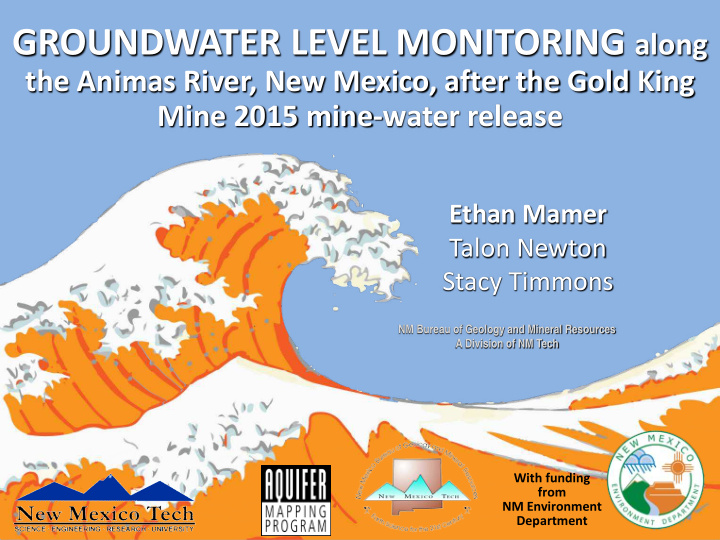



GROUNDWATER LEVEL MONITORING along the Animas River, New Mexico, after the Gold King Mine 2015 mine-water release Ethan Mamer Talon Newton Stacy Timmons NM Bureau of Geology and Mineral Resources A Division of NM Tech With funding from NM Environment Department
Gold King Mine Spill • August 5, 2015 • ~3 million gallons of mine- waste water, and 540 tons of mine-waste sediment were released into the Animas near Silverton, CO Figure from EPA, 2017
Gold King Mine Spill – Dissolved contaminants flowed past Farmington within a week of the spill – Contaminated sediments were deposited and left behind Figure from EPA, 2017
Gold King Mine Spill • EPA findings (2017) – 90% of sediments were deposited along the Animas River upstream of Farmington after spill – Remaining sediments were transported out of the system during 2015 fall storms and 2016 snow melt Figure from EPA, 2017
Study Area • Goals: – Evaluate groundwater-surface water interaction – Describe annual and seasonal fluctuations – Determine any “at risk” locations along the river
Groundwater Monitoring Network: Manual measurements • Between 59 and 74 wells measured during each seasonal transition. • USGS WL steel tape protocol 8 measurement • periods • August ‘15 –June ’17 • ~ 640 WL measurements
Animas River stage: Manual measurement periods • Network measured 4 times a year • Measurement timing intended to capture hydraulically significant periods in the groundwater/ surface water system Winter Baseflow in river (late January) • Pre-irrigation season (late March) • Peak river flow (early June) • End of irrigation season (October)
Groundwater Monitoring Network: Continuous data loggers • 24 wells instrumented with • 5 barometer loggers pressure transducers installed along Animas • 2 installed September ‘15 reach for barometric • 2 installed January ’16 corrections • 1 installed in June ‘16 • 19 installed late ’16/ early ‘17 • Monitor water levels and temperature every hour • 13 also monitor the specific conductance
Summer Low June High Winter High • Little can be determined from manual measurements alone October High
Summer Low June High Winter High • Combining pressure transducer record with manual measurements we October High can extrapolate trends to wells without complete records
River Stage Controlled (22 of 70) • Very close to river: median 320 ft • Median water table is 9.4 ft bgs • Small seasonal fluctuation: median 3.5 ft • Water levels are hydraulically linked to the river and closely follow the fluctuations in stage
Irrigation controlled (38 of 70) • Much farther from river: median 1,810 ft • Deeper water table: median 14.7 ft • Large seasonal fluctuation: median 5.7 ft • Aquifer is recharged during the irrigation season, during which water levels recover, before dropping when ditches are shut off
Winter-recharge/ Summer evapotranspiration (10 of 70) • Farther from river: median 1,160 ft • Small seasonal fluctuation: median 2.1 ft • Very shallow WT: median 2.5ft • Summer decline is related to vegetation drawing from the aquifer
Gaining stream • Water table is HIGHER than the river, and water flows into the river from the surrounding aquifer. Losing stream • Water table is LOWER than the river, and water infiltrates into the aquifer from the river.
Reaches where water table gradient has been found to be flat or slightly losing during winter.
Water table in October
Water table in March
How close is too close? • Using the water table maps to calculate the gradient in losing reaches • Approximating the conductivity of the alluvial aquifer and its porosity • We can calculate the distance river water can travel during the winter. • ~2 feet/day • ~130ft in 9 weeks
Still a GAINING RIVER overall • During Winter, when no water is being diverted into the Ditches, water is moving from the alluvial aquifer into the river.
• Most of Animas River has gaining conditions. • Seasonal fluctuations in river stage and water levels are enough to reverse groundwater/ surface water flow direction. • Potential for future contamination from lingering sediments, and reversals in groundwater flow • The river and the groundwater in the valley are hydrologically connected. • The irrigation ditch water is feeding the shallow water table, recharging groundwater during the irrigation season. – Potential pathway for contamination to enter aquifer
Acknowledgments Very kind landowners • • NM Environment Department - Dennis McQuillan, Diane Agnew, Patrick Longmire, Kris Pintado • U.S. EPA – Funding to NMED • USGS - Jesse Driscoll, Lauren Sherson, Nicole Thomas, Amy Gallanter NMOSE – Doug Rappuhn, Rob Pine, • Shawn Williams • NMBGMR/NMT - Trevor Kludt, Scott Christenson, Kitty Pokorny, Brigitte Felix, Sara Chudnoff, Bonnie Frey, Dustin Baca, Geoff Rawling, Mark Mansell, Kylian Robinson NM Bureau of Geology and Mineral Resources NM Bureau of Geology and Mineral Resources
Recommend
More recommend